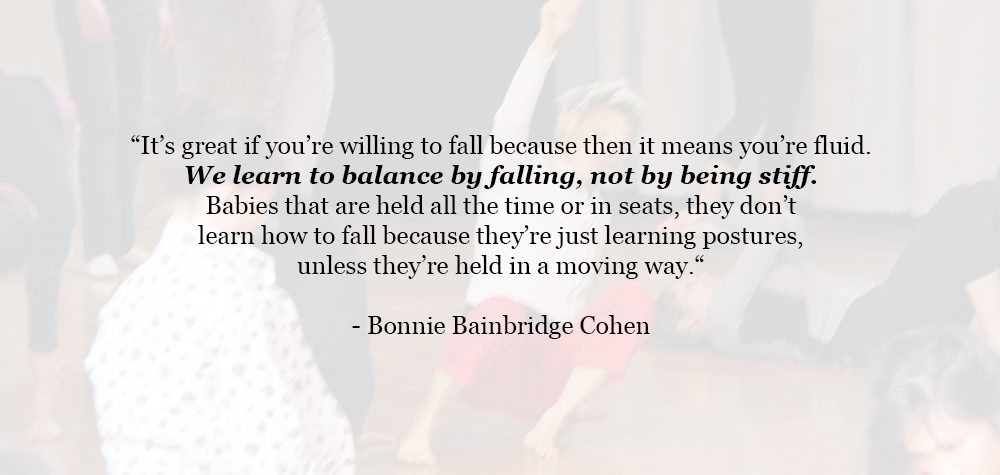
© Bonnie Bainbridge Cohen
Question: How can we learn to balance if we’re afraid of falling?
Bonnie: How can we learn to balance if we are afraid of falling, especially if we have a history of injuries, stiffness or other mobility issues, is a very challenging question. It is also difficult to respond to in words but, here is a go at one aspect regarding the development of equilibrium.
Usually when we think of falling, we are focused on gravity, i.e. falling toward the earth’s center. However, underneath our falling outward toward the earth’s center is our falling inward toward our own center.
Developmentally, this initially emerges in the oceanic womb and further evolves on land during our first year of life, and throughout life, through the pattern I have named Navel Radiation (one of the Basic Neurocellular Patterns, also called BNP). In Navel Radiation, all of our six limbs (head, tail, arms, and legs) flow inward and outward via the navel. They also integrate with each other through our navel center as a six-limbed starfish. The movement can be initiated centrally from the navel or distally from the ends of the limbs. Orientation occurs around our navel center before it is established around our spine and vertical axis.
It would be wonderful if all the people caring for babies understood how to hold and move a baby with awareness and support of the baby’s (and their own) pattern of falling around the navel center.
However, this is not yet included in our general education. Babies are typically held and moved, in a way, as passive objects. The underlying baby’s movement is secondary to the caregiver’s movement, instead of the caregiver basing their movement on the baby’s movement.
Another way to say this is, how do we move a baby in ways that the baby’s innate developmental movement and perceptual processes are integrated so that the baby feels and registers in their brain that they are in control of their own movement.
Another aspect of the question is how can we as adults uncover or recover the equilibrium responses that never developed or perhaps developed but were lost. This, of course, is possible and a major focus of Body-Mind Centering®. It is a deep movement practice.
Since we are talking about falling, it is important to approach it in ways that are safe, especially if there are physical problems present. As an introduction, one place to begin is to lie down on the floor or bed. Then gently roll onto all four surfaces of your body (side, back, side, belly) by folding and unfolding, oriented around your navel. Move slowly and sequentially.
Instead of directing the movement from the front of your brain, open the back of your brain to receive the information from the cells of your whole body (even your head!). In time, this may progress to changing levels in space. Also, explore and share with others for support and further insights.
For further information, I have just completed a book on the Basic Neurocellular Patterns called Basic Neurocellular Patterns: Exploring Developmental Movement. There are also two chapters on the Primitive Reflexes, Righting reactions, and Equilibrium Responses (RRR) in my book, Sensing, Feeling, and Action. I am currently writing a book on the RRR. The BNP and RRR are two of a series of seven books that I am writing on the development of movement and consciousness.
It is taking me a lot of words and years to write and research my response to your question. Thank you for sharing the inquiry.